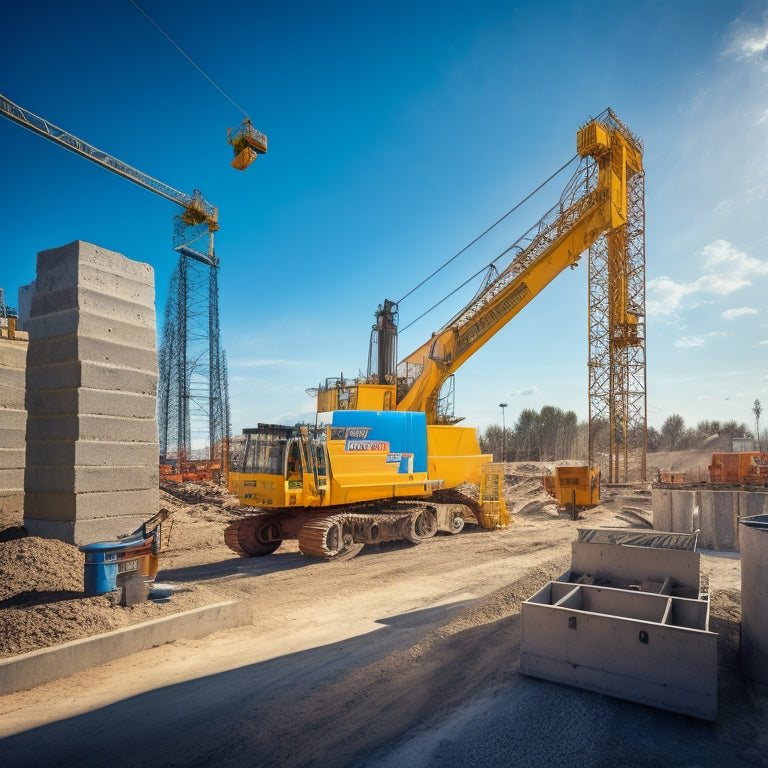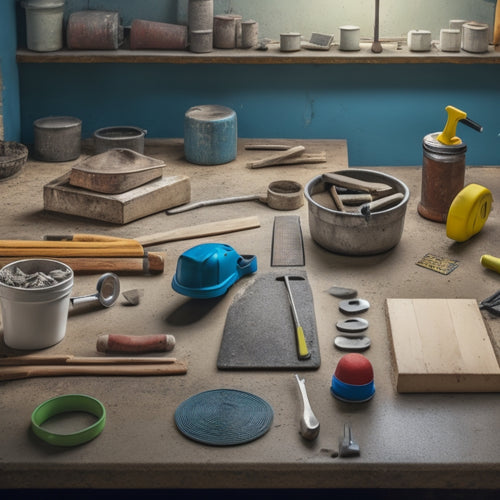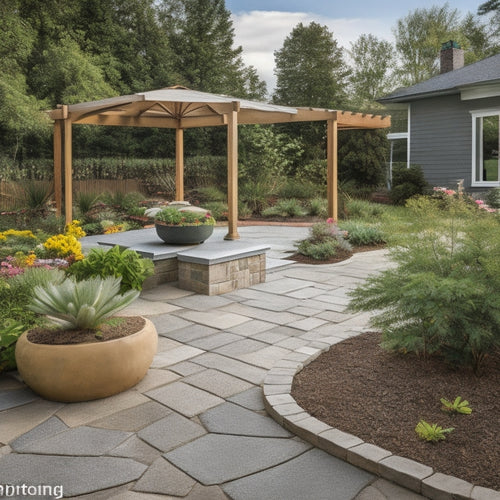
Top Tools for Concrete Block Construction Success
Share
You'll need a well-stocked toolkit with a mix of hand tools, power tools, measuring and testing tools, safety gear, and specialized equipment for mixing, pouring, and finishing to guarantee concrete block construction success. Essential hand tools include trowels, jointers, and levels, while power tools like drill presses and saws with diamond-coated or carbide-tipped blades are critical for precision cuts. You'll also need measuring and testing tools like spirit levels, compression testing machines, and moisture meters to guarantee accuracy and quality. With the right tools, you'll be well on your way to achieving professional results - now, take a closer look at each category to optimize your toolkit.
Key Takeaways
• A combination of hand tools, power tools, and measuring/testing tools are essential for concrete block construction success.
• Investing in high-quality tools, such as a drill press and precision squares, ensures accuracy and efficiency.
• Regular maintenance of tools and equipment is crucial to prevent damage and ensure optimal performance.
• Specialized tools, like a compression testing machine and moisture content check tools, help ensure block strength and quality.
• Safety gear, such as hard hats and dust masks, is vital to protect workers from hazards and injuries during construction.
Must-Have Hand Tools
Your concrete block construction toolkit should include a set of essential hand tools that guarantee efficient and accurate work. As you master block handling techniques, you'll realize that having the right tools is significant for success.
A trowel, for instance, is critical for applying and leveling mortar. A jointer or pointing trowel helps to finish joints and correct any imperfections. A level guarantees your blocks are properly aligned, while a string line helps maintain straight courses.
Don't forget a hammer for tapping blocks into place and a utility knife for cutting excess mortar. To prolong the life of your tools, follow tool maintenance tips such as cleaning them regularly, storing them in a dry place, and lubricating moving parts. Proper tool care will save you time and money in the long run.
Essential Power Tools
When working with concrete blocks, you'll need power tools that can efficiently handle the tasks at hand.
You'll rely on your drill press to make precise holes for anchors and rebar, so it's essential to guarantee accuracy in your drill press setup.
Next, you'll select the right saw blade for your circular saw or masonry saw to make clean cuts through the blocks.
Drill Press Accuracy
Achieving accurate hole placement and maintaining precise control over drill bit movement are vital aspects of concrete block construction, making a drill press an indispensable power tool in your arsenal.
To master drill press techniques, you'll need to develop a solid understanding of how to properly set up and operate this equipment. Start by verifying your drill press is properly calibrated and aligned, as even slight deviations can result in inaccurate hole placement.
Regular drill press maintenance is also essential, as worn or damaged components can compromise the accuracy of your drill bits. Make it a habit to regularly inspect and clean your drill press, replacing worn parts as needed.
By honing your drill press skills and staying on top of maintenance, you'll be able to achieve precise control over drill bit movement and guarantee accurate hole placement every time.
With practice and attention to detail, you'll be able to tackle even the most complex concrete block construction projects with confidence.
Saw Blade Selection
Selecting the right saw blade for your concrete block construction project is critical, as it directly impacts the quality of your cuts and the overall efficiency of your workflow.
You'll want to choose a blade that's specifically designed for cutting concrete blocks, as it will help you achieve clean, precise cuts with minimal waste. When selecting a saw blade, take into account the blade materials and their suitability for your project. For example, diamond-coated blades are ideal for cutting through hard, abrasive materials like concrete, while carbide-tipped blades are better suited for softer materials.
You'll also want to take into account the cutting techniques you'll be using. Will you be making straight cuts, or do you need to make curved or angled cuts? Different blades are designed for specific cutting techniques, so it's crucial to choose a blade that's compatible with your needs.
Additionally, take into account the blade's speed and feed rate, as these factors will impact the quality of your cuts and the overall efficiency of your workflow. By selecting the right saw blade, you'll be able to achieve professional-grade results and take your concrete block construction project to the next level.
Measuring and Testing Tools
When you're working with concrete blocks, accuracy is vital.
You'll need to guarantee your blocks are properly aligned and level, which is where measuring and testing tools come in.
You'll be using these tools to check the strength of your blocks, verify their moisture content, and confirm their alignment.
It's important to have the right ones for the job.
Level and Alignment
You'll need a range of specialized tools to confirm your concrete block construction is perfectly level and aligned. This is vital, as even slight deviations can compromise the structural integrity of your project.
To verify accuracy, invest in a high-quality spirit level, which will enable you to make precise level adjustments. A laser level is also essential, as it projects a level plane onto the surrounding area, allowing you to verify alignment across the entire site.
When it comes to alignment techniques, a string line and pins are indispensable. These tools enable you to establish a precise reference point, confirming that your blocks are laid in perfect alignment.
Additionally, precision squares and straightedges will help you maintain accurate angles and edges. By combining these tools, you'll be able to achieve precise level and alignment, resulting in a structurally sound and aesthetically pleasing concrete block construction project.
Block Strength Testing
To determine the compressive strength of your concrete blocks, you'll need to employ specialized measuring and testing tools that can accurately assess their load-bearing capacity. For block durability assessment, you'll want to use a compression testing machine, which applies a controlled force to the block until it fails. This helps you evaluate the block's compressive strength, making certain it meets the required standards.
When conducting compressive strength evaluation, it's important to follow established testing protocols, such as those outlined in ASTM C39/C39M. This guarantees that your test results are reliable and consistent. You'll also need to prepare the blocks correctly, including capping them with a sulfur or neoprene pad to ensure even load distribution.
Additionally, consider using a data acquisition system to record and analyze the test data, providing you with detailed insights into the block's performance. By using these tools and following proper testing procedures, you can confidently assess the strength and durability of your concrete blocks, making certain a structurally sound construction project.
Moisture Content Check
Approximately 75% of concrete block failures can be attributed to excess moisture, making it vital that you determine the moisture content of your blocks to guarantee peak strength and durability.
To do this, you'll need to employ accurate moisture measurement techniques. You can use a variety of tools, such as hygrometers, calcium carbide meters, or oven-drying methods, to measure the moisture content of your blocks. It's important to choose the right tool for your specific needs, considering factors like block size, material, and the level of accuracy required.
Once you've determined the moisture content, you can develop effective drying methods to make certain your blocks are dry enough for construction. This may involve controlling the curing environment, using desiccants, or applying heat to speed up the drying process.
Safety and Protection Gear
When working with concrete blocks, wearing the right safety and protection gear is essential, as it shields you from potential hazards like heavy block falls, abrasions, and airborne particles. You must prioritize personal protective equipment (PPE) to guarantee compliance with safety regulations and prevent injuries.
Here are the top safety essentials to include in your concrete block construction toolkit:
-
Hard Hats: Protect your head from falling objects, debris, and electrical hazards.
-
Safety Glasses: Shield your eyes from flying particles, chemical splashes, and other hazards.
-
Dust Masks: Filter out airborne particles, such as silica dust, to prevent respiratory problems.
Mixing and Pouring Equipment
With your safety gear in place, you're ready to move on to the critical step of mixing and preparing the concrete, which requires a set of specialized tools to secure a strong and consistent final product.
A portable concrete mixer is a must-have for efficient and thorough mixing. Choose a mixer that can handle the volume of concrete you need, and consider one with adjustable mixing speeds to accommodate different mixing techniques. For smaller batches, a wheelbarrow mixer can be a cost-effective alternative.
When it comes to pouring methods, a concrete pump or a power buggy can greatly simplify the process. A concrete pump allows you to pour large quantities quickly and accurately, while a power buggy helps you transport and place the concrete with ease.
Additionally, a pouring bucket or a concrete chute can help you direct the flow of concrete into the block molds. By investing in the right mixing and pouring equipment, you'll be able to achieve a high-quality finish and secure the structural integrity of your concrete block construction project.
Finishing and Smoothing Tools
You'll need a range of specialized finishing and smoothing tools to refine the surface of your concrete blocks, ensuring a uniform appearance and ideal bonding with subsequent layers. These tools will help you achieve a smooth, even finish that's vital for structural integrity and aesthetic appeal.
Here are three vital finishing and smoothing tools you should have in your arsenal:
-
Trowels: Mastering trowel techniques is essential for achieving a smooth, even finish. Invest in a range of trowels with different blade angles and sizes to tackle various surface treatments.
-
Floats: These tools are designed to remove excess material and smooth out the surface of your concrete blocks. They come in various sizes and are ideal for large, flat areas.
-
Edgers: Edgers are used to create clean, defined edges and corners. They're especially useful for creating a professional finish around joints, corners, and other areas where blocks meet.
Frequently Asked Questions
How Do I Prevent Concrete Blocks From Shifting During Construction?
To prevent concrete blocks from shifting during construction, you'll need to employ effective block stabilization methods and shifting prevention techniques.
Start by ensuring a level and compacted foundation, then use a spirit level to check block alignment.
Next, apply a bonding agent to the block surfaces and use a string line to maintain straight courses.
Additionally, use temporary bracing and spacers to hold blocks in place until the mortar sets, guaranteeing a stable structure.
Can I Use Concrete Blocks for Building Foundations and Basements?
'Oh, you want to build a foundation and basement with concrete blocks? Brave move! But seriously, it's not a bad idea.
You can use concrete blocks for building foundations and basements, but it's essential to choose the right foundation type. Make sure the blocks are durable enough to withstand soil pressure and water exposure.
In fact, solid concrete blocks are ideal for frost-protected shallow foundations and unreinforced foundations.
Just remember to follow local building codes and consult with a structural engineer to guarantee your project's success.'
What Is the Ideal Temperature for Laying Concrete Blocks?
When you're laying concrete blocks, you're likely wondering what the ideal temperature is. The answer lies in understanding block curing methods.
Temperature effects play an essential role, as it directly impacts the hydration process. Aim for a temperature between 50°F and 70°F (10°C and 21°C) for the best curing.
Avoid extreme temperatures, as they can lead to weak bonds or excessive shrinkage. By controlling the temperature, you guarantee a strong and durable block structure.
How Do I Ensure Accurate Block Alignment and Plumb Walls?
Are you tired of wonky walls and misaligned blocks? To guarantee accurate block alignment and plumb walls, you'll need to master a few essential techniques.
Start by using a spirit level to check the block's orientation as you lay it.
Next, employ a string line to maintain a straight course, and use a laser level to verify the wall's plumbness.
Finally, implement a 'lead and follow' block laying strategy to maintain alignment.
With these techniques, you'll be well on your way to achieving precision alignment and plumb walls.
Can I Reuse Concrete Blocks From a Demolished Structure?
When considering reusing concrete blocks from a demolished structure, you'll need to weigh block recycling benefits against structural integrity concerns.
You'll want to inspect each block for cracks, damage, and signs of wear, as compromised blocks can jeopardize the entire structure. Additionally, guarantee the blocks meet current building codes and standards.
If they pass muster, reusing them can reduce waste, conserve resources, and even offer cost savings.
However, prioritizing structural integrity is essential to guarantee a safe and durable build.
Conclusion
You've got all the blocks in place for concrete block construction success.
Now, it's time to hammer it home. With these top tools, you'll be building a strong foundation for your project.
Remember, a house is only as strong as its foundation, so don't skimp on the essentials.
Lay the groundwork for success by investing in the right tools, and you'll be building a concrete block structure that will stand the test of time.
Related Posts
-

Must-Have Tools for Laying Concrete Tiles
When laying concrete tiles, you'll need a range of essential tools to get the job done right. Start with subfloor pre...
-

Essential Tools for Concrete Wall Covering Projects
When tackling a concrete wall covering project, you'll need a range of essential tools and equipment. For cleaning an...
-

Why These Tools Are Crucial for Concrete Patio
You're about to commence on a concrete patio project, and having the right tools is vital to achieving professional-l...


